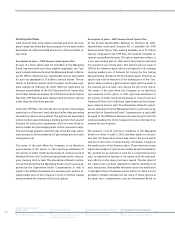Siemens 2009 Annual Report Download - page 281
Download and view the complete annual report
Please find page 281 of the 2009 Siemens annual report below. You can navigate through the pages in the report by either clicking on the pages listed below, or by using the keyword search tool below to find specific information within the annual report.
Managing Board statements, Independent auditors’ report, Additional information
Notes to Consolidated Financial Statements
(in millions of €, except where otherwise
stated and per share amounts)
sociated financial market risks. The Company seeks to manage
and control these risks primarily through its regular operating
and financing activities, and uses derivative instruments when
deemed appropriate.
Management of financial market risk is a key priority for
Siemens’ Managing Board. As a member of this Board, the
Chief Financial Officer covers the specific responsibility for this
part of the overall risk management system. At the highest
level, the Managing Board retains ultimate accountability. For
practical business purposes, the Managing Board delegates
responsibilities to central functions and to the Siemens’ seg-
ments and entities. SFS holds a minor trading portfolio which
is subject to tight limits. As of September 30, 2009, it has a
value at risk (VaR) close to zero.
Within the various methodologies to analyze and manage risk,
Siemens implemented a system based on parametric variance-
covariance VaR. The VaR methodology provides a quantifica-
tion of the market risk based on historical volatilities and cor-
relations of the different risk factors under the assumptions of
the parametric variance-covariance value at risk model. The
VaR figures are calculated based on
▪ historical volatilities and correlations,
▪ a 10 day holding period and
▪ a 99.5 percent confidence level
for all risk factors.
Actual results that are included in the Consolidated State-
ments of Income differ substantially from VaR figures due to
fundamental conceptual differences. The Consolidated State-
ments of Income are prepared in accordance with IFRS. The
VaR figures result from a pure financial calculation model
which calculates a potential financial loss which does not ex-
ceed within 10 days and with a probability of 99.5 percent the
stated VaR. Since the Value at Risk is used for internal manage-
ment of the Treasury activities and provides more relevant risk
information compared to the sensitivity analysis, VaR figures
have been introduced within our financial market risk disclo-
sures for the first time.
Changes in the fair value of interest rate swap contracts and
the offsetting changes in fair value of the Available-for-sale fi-
nancial assets being hedged attributable to the interest rate
risk being hedged were recognized as adjustments to the line
item Financial income (expense), net in the Consolidated
Statements of Income. The net effect recognized in Financial
income (expense), net, representing the ineffective portion of
the hedging relationship, amounted to €– in fiscal 2008.
Cash flow hedges of revolving term deposits
During the years ended September 30, 2009 and 2008, the
Company applied cash flow hedge accounting for a revolving
term deposit. Under the interest rate swap agreements en-
tered into, the Company agrees to pay a variable rate of inter-
est multiplied by a notional principal amount, and to receive in
return an amount equal to a specified fixed rate of interest
multiplied by the same notional principal amount. These inter-
est rate swap agreements offset the effect of future changes in
interest payments of the underlying variable-rate term de-
posit. The interest rate swap contracts are reflected at fair
value and the effective portion of changes in fair value of the
interest rate swap contracts that were designated as cash flow
hedges are recorded in Other components of equity; any inef-
fective portion of changes in fair value are recognized in profit
or loss. In fiscal 2009 and 2008, the cash flow hedges of revolv-
ing term deposits did not lead to any material ineffective por-
tions recognized in profit or loss (less than €1). Net cash re-
ceipts and payments relating to such interest rate swap agree-
ments are recorded as interest income, which is part of
Financial income (expense), net.
FINANCIAL RISK MANAGEMENT
Market risks
Increasing market fluctuations may result in significant cash-
flow and profit volatility risk for Siemens. Its worldwide operat-
ing business as well as its investment and financing activities
are affected by changes in foreign exchange rates, interest
rates and equity prices. To optimize the allocation of the finan-
cial resources across the Siemens’ segments and entities, as
well as to secure an optimal return for its shareholders,
Siemens identifies, analyzes and proactively manages the as-
























